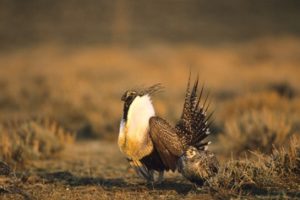In his continuing effort to bring Department of the Interior (DOI) policies into step with President Donald Trump’s Executive Order on U.S. energy independence, Interior Secretary Ryan Zinke has issued another secretarial order of his own, this one to initiate reviews of federal and state plans affecting conservation of the greater sage-grouse.

twildlife / iStock / Getty Images Plus / Getty Images
One objective of the order is to “sustain healthy populations of the species.” The order also requires that provisions of the plans be modified or rescinded “to give appropriate weight to the value of energy and other development of public lands within [the DOI’s Bureau of Land Management’s [BLM]] overall multiple-use mission.”
In March 2017, Zinke signed secretarial orders to end President Barack Obama’s 2016 moratorium on all new coal leases on federal land and order reviews of any prior DOI actions that may hamper “responsible energy development.” Other orders regarding offshore energy development and energy developing in Alaska have also been signed by Zinke.
Decision Not to List
The iconic greater sage grouse is found in 11 western states and two Canadian provinces. In all, its range stretches across 257,000 square miles, with about half the population on public land. The species has been in decline due to development on its habit. In 2011, the U.S. Fish and Wildlife Service (FWS) declared the bird a candidate for listing under the Endangered Species Act (ESA). At that time, the BLM announced that it would work with the western states to build new sage grouse protection strategies and plans. The plans were subsequently cited by the FWS as a key reason for deciding that the greater sage-grouse did not merit protection under the ESA. The Western Governors Association (WGA) has cooperated in the conservation strategy.
“Western Governors are committed to conservation of greater sage-grouse and assert that the breadth and depth of voluntary conservation efforts across the region, if allowed to run their course, will provide the bird with the necessary habitat to live and thrive,” says the WGA. “The Governors believe that a [ESA] listing of the greater sage-grouse by FWS will diminish the amount of new voluntary conservation work undertaken and have a significant, negative economic impact across the West.”
States at Forefront
The first-listed “purpose” of Zinke’s order is to enhance cooperation between the DOI and the states.
“While the federal government has a responsibility under the Endangered Species Act to responsibly manage wildlife, destroying local communities and levying onerous regulations on the public lands that they rely on is no way to be a good neighbor,” said Zinke. “State agencies are at the forefront of efforts to maintain healthy fish and wildlife populations, and we need to make sure they are being heard on this issue. As we move forward with implementation of our strategy for sage-grouse conservation, we want to make sure that we do so first and foremost in consultation with state and local governments, and in a manner that allows both wildlife and local economies to thrive. There are a lot of innovative ideas out there. I don’t want to take anything off the table when we talk about a plan.”
Zinke’s order establishes a Sage-Grouse Review Team comprising representatives of the BLM, FWS, and U.S. Geological Survey. The team will review all federal and state plans to ensure they are complementary and achieve the dual goal of conservation and energy/economic growth.
Short-Term Profits
Responding to Zinke’s order, the Center for Biological Diversity conceded that “unprecedented” 5-year effort, led by the DOI, resulted in land-use plans with new measures to conserve sage grouse and potentially prevent the need to list the species as endangered. But that effort will be defeated as Zinke’s order is implemented, said the Center.
“Zinke’s ‘review’ is clearly a pretext to push the sage grouse to extinction in return for short-term profits for his corporate buddies, said Randi Spivak, public lands program director with the Center. “They might as well form a shotgun posse to kill off the species directly. We’ll do everything in our power to make sure this amazing bird and its habitat are protected.”
Report Assesses Overlap
In a related development, Backcountry Hunters and Anglers (BHA) issued a report that found that 79 percent of areas that are on western public lands and that have medium to high potential for energy development fall outside of sage grouse habitat.
Prepared by Western EcoSystems Technology Inc., the report looks at sage grouse priority habitat management areas (PHMA) that the BLM has identified in sage grouse management plans and evaluates the overlap between these areas and existing leases and rights-of-way for energy development. According to the BHA, there is an overlap of only 4 percent between PHMAs and existing coal and oil and gas leases on federal lands.
“Our sagebrush steppe is a resource of incalculable value—an ecosystem that, with its robust fish and wildlife populations, diverse recreational offerings and public lands hunting and fishing opportunities, anchors the economies of states and communities across the West,” said BHA Conservation Director John Gale. “Energy development is an appropriate and necessary use of our public lands, particularly in the West, yet it must be pursued responsibly and in the right places.”
Information on the BHA report is here.
